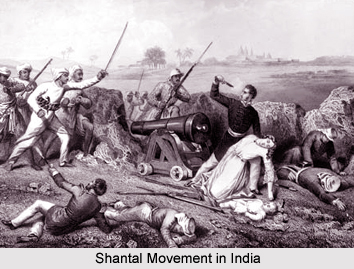 History of Sahibganj District in Jharkhand is rich and interesting. It revolves mainly around the history of Rajmahal, Teliagarhi Fort and Sahibganj Town itself. The history of Sahibganj District is inseparable from the history of its parent district of Santhal Pargana with its headquarters at Dumka and is interrelated with the histories of Godda District, Dumka District, Deoghar District and Pakur District. As a direct consequence of the Santhal Rebellion of 1854-55, Santhal Pargana has been created as a separate district in 1855 by ceding portions of Bhagalpur and Birbhum District.
History of Sahibganj District in Jharkhand is rich and interesting. It revolves mainly around the history of Rajmahal, Teliagarhi Fort and Sahibganj Town itself. The history of Sahibganj District is inseparable from the history of its parent district of Santhal Pargana with its headquarters at Dumka and is interrelated with the histories of Godda District, Dumka District, Deoghar District and Pakur District. As a direct consequence of the Santhal Rebellion of 1854-55, Santhal Pargana has been created as a separate district in 1855 by ceding portions of Bhagalpur and Birbhum District.
The early history of Sahibganj District gives evidences that the area is inhabited since time immemorial by Mal Paharia Tribe. Medieval history of Sahibganj District states that on 12th of July 1576, the battle of Rajmahal was fought and the foundation of the Mughal rule in Bengal was laid. It was Man Singh, general of Akbar, who made Rajmahal the capital of Bengal in 1592. But this honour of Rajmahal was short-lived, as the capital was shifted to Dacca in 1608. In 1639, Rajmahal regained its glory and was made the capital of Bengal by Shah Shuja, second son of Emperor Shah Jahan, on his appointment as the Viceroy of Bengal. It continued as the seat of the Mughal Viceroy up to 1660.
After the victory at the Battle of Plassey, Bengal which contained the present Sahibganj District was captured by the rulers of British East India Company. In Santhal Pargana, they were opposed by the Paharias. Santhals settled in the district after migrating from Birbhum District, Bankura District, Hazaribagh District and Rohtas within 1790 to 1810. The Santhals became an easy prey to the unscrupulous hill-men and non-Santhal traders. They were exploited them to the maximum. These entire facts and circumstances led to the Santhal Rebellion of 1855. The object of the Santhal uprising was the economic liberation of the Santhals. The first spark of the revolt was ignited at Littipara. The Santhal rebellion was the predecessor of the first Indian Freedom Movement of 1857. Sahibganj province was not immune from patriotic fervor, and played its role in the country`s struggle for freedom from 1921 onwards. The district played its role in the Salt Satyagraha Movement and the Civil Disobedience Movement of 1930. The movement gathered momentum and the British Government had to send military forces to control the situation.
History of Sahibganj District also states that after the independence of the country, government considered the Paharias and other tribal groups of Rajmahal hills as demographically underdeveloped section of the society. So, new policies and plans for their emancipation were planned. The Jharkhand Movement for more empowerment spearheaded by tribal communities and demand for separate statehood thus gained momentum and finally on 15th November 2000, a separate state named as Jharkhand came into existence comprising 18 districts of the Chota Nagpur Plateau and Santhal Pargana divisions.






